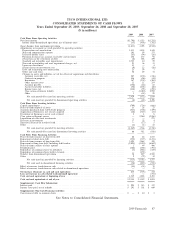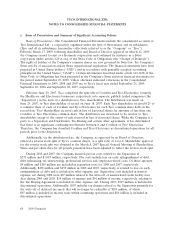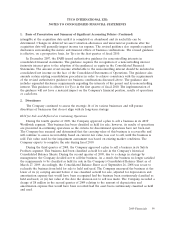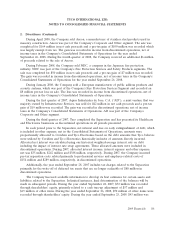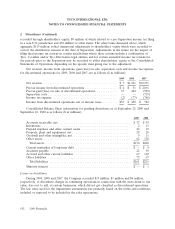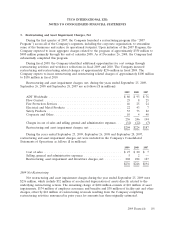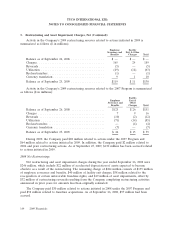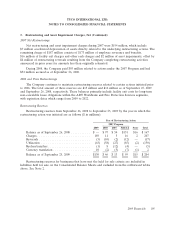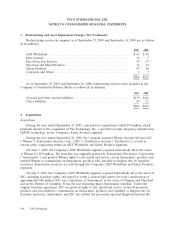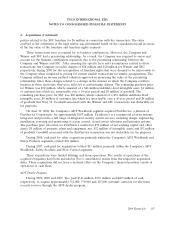ADT 2009 Annual Report Download - page 189
Download and view the complete annual report
Please find page 189 of the 2009 ADT annual report below. You can navigate through the pages in the report by either clicking on the pages listed below, or by using the keyword search tool below to find specific information within the annual report.TYCO INTERNATIONAL LTD.
NOTES TO CONSOLIDATED FINANCIAL STATEMENTS
1. Basis of Presentation and Summary of Significant Accounting Policies (Continued)
an irrevocable election to account for certain types of financial instruments and warranty and insurance
contracts at fair value, rather than historical cost, with changes in the fair value, whether realized or
unrealized, recognized in earnings. The guidance became effective for the Company in the first quarter
of 2009 at which time the Company did not elect the fair value option for eligible items.
In September 2006, the FASB issued authoritative guidance for fair value measurements, which
enhances existing guidance for measuring assets and liabilities at fair value. The guidance defines fair
value, establishes a framework for measuring fair value and expands disclosure about fair value
measurements. In February 2008, the FASB issued authoritative guidance which permits companies to
partially defer the effective date of the guidance for one year for nonfinancial assets and liabilities that
are recognized or disclosed at fair value in the financial statements on a nonrecurring basis. During the
first quarter of 2009 the Company elected to defer the adoption of the guidance for one year for
non-financial assets and liabilities that are recognized or disclosed at fair value in the financial
statements on a nonrecurring basis which is effective for Tyco in first quarter of fiscal 2010, on a
prospective basis. The guidance became effective for Tyco in the first quarter of fiscal 2009 for financial
assets and liabilities only. The adoption did not have a material impact on the Company’s financial
position, results of operations or cash flows. See Note 14 for additional information related to the
adoption of the guidance.
In September 2006, the FASB issued authoritative guidance for employers’ accounting for defined
benefit pension and other postretirement plans. The guidance requires that employers recognize the
funded status of defined benefit pension and other postretirement benefit plans as a net asset or
liability on the Consolidated Balance Sheets and recognize as a component of accumulated other
comprehensive (loss) income, net of income taxes, the gains or losses and prior service costs or credits
that arise during the period but are not recognized as a component of net periodic benefit cost. The
Company adopted the recognition and disclosure provisions of the guidance as of September 28, 2007.
The guidance also requires companies to measure plan assets and benefit obligations as of their
fiscal year end. The Company adopted the measurement date provisions of the guidance on
September 27, 2008. As a result, Tyco measured its plan assets and benefit obligations on
September 26, 2008 and adjusted its opening balances of accumulated (deficit) earnings and
accumulated other comprehensive (loss) income for the change in net periodic benefit cost and fair
value, respectively, from the previously used measurement date of August 31, 2008. The adoption of
the measurement date provisions resulted in a net decrease to accumulated (deficit) earnings of
$5 million, net of an income tax benefit of $2 million, and a net increase to accumulated other
comprehensive (loss) income of $61 million, net of income taxes of $28 million for 2009. See Note 16
for additional information related to the adoption of the guidance.
Recently Issued Accounting Pronouncements—In September 2009, the FASB issued authoritative
guidance for the accounting for revenue arrangements with multiple deliverables. The guidance
establishes a selling price hierarchy for determining the selling price of a deliverable. The selling price
used for each deliverable will be based on vendor-specific objective evidence if available, third-party
evidence if vendor-specific objective evidence is not available, or estimated selling price if neither
vendor-specific evidence nor third-party evidence is available. The guidance requires arrangements
under which multiple revenue generating activities to be performed be allocated at inception. The
residual method under the existing accounting guidance has been eliminated. The guidance expands the
disclosure requirements related to multiple-deliverable revenue arrangements. The guidance becomes
effective for revenue arrangements entered into or materially modified beginning in fiscal 2011, with
2009 Financials 97


